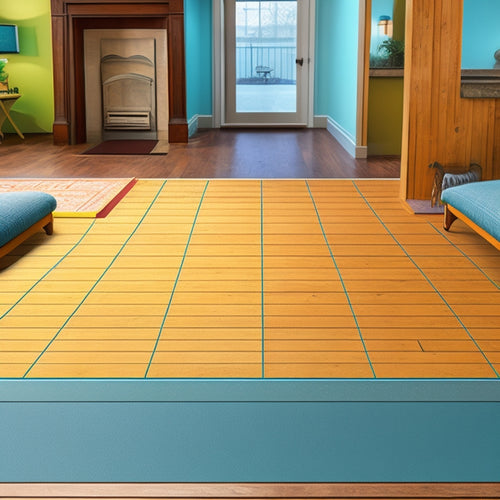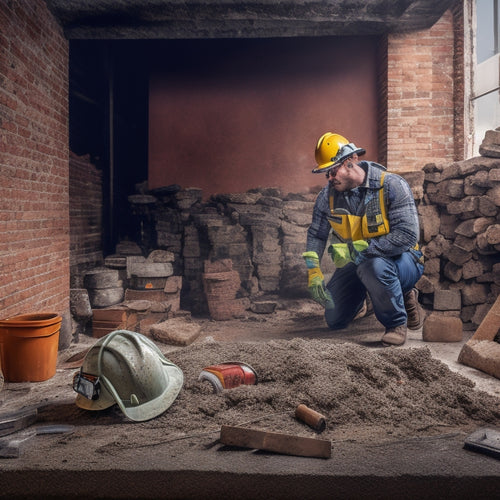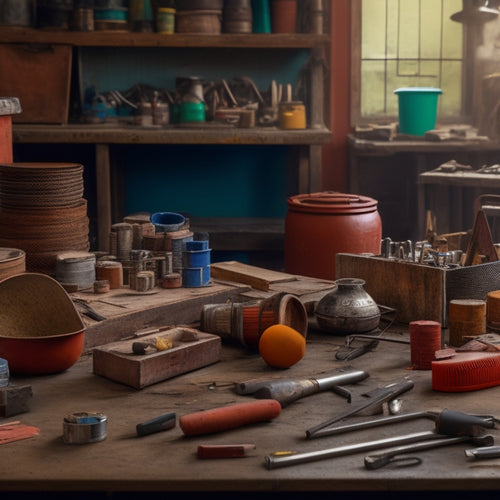
Top 3 Sanders for Smoothening Home Renovation Surfaces
Share
When it comes to smoothening home renovation surfaces, you need the right sander for the job. For large, flat surfaces, the Makita 9404 belt sander is a top pick, offering heavy-duty performance and adjustable belt tracking for precision. For smaller areas, the Bosch ROS20VSC orbital sander is a favorite among pros and DIYers, delivering high-quality finishes with its 2.5-amp motor and variable speed control. For detailed work, the DeWalt DWE6401DS is a top contender, fitting into tight spaces and achieving smooth finishes with its 3-amp motor. Now that you've got the top three, you can explore how to maximize their potential for a flawless renovation.
Key Takeaways
• For smoothening home renovation surfaces, consider the project-specific needs, such as surface type and size, to choose the right sander.
• Belt sanders are ideal for large, flat surfaces like wooden floors, while orbital sanders are suitable for small to medium surfaces.
• Random orbital sanders offer versatility and balance speed and control, making them a great option for diverse applications.
• The top-rated sander models, such as Bosch ROS20VSC, Makita 9404, and DeWalt DWE6401DS, are designed for high-quality finishes on wood, metal, and drywall.
• Prioritize quality brands and evaluate performance features, such as sander power, dust collection, and ergonomics, to ensure improved sanding efficiency.
Choosing the Right Sander Type
When tackling a home renovation project, you need to select the right sander type to guarantee a smooth finish and efficient workflow. With various sander types available, it's essential to understand their applications to make an informed decision.
Belt sanders, for instance, are ideal for large, flat surfaces and removing old finishes. They're perfect for sanding down wooden floors, removing old paint, or smoothening out drywall.
Orbital sanders, on the other hand, are versatile and suitable for general-purpose sanding. They're great for sanding small to medium-sized surfaces, removing rust, and polishing metal.
Detail sanders, with their triangular or rectangular heads, are designed for precision work, making them perfect for sanding tight spaces, corners, and intricate designs.
Random orbital sanders, a hybrid of belt and orbital sanders, offer a balance between speed and control, making them suitable for a wide range of applications.
Key Features to Consider
You'll want to evaluate several key features when selecting a sander to guarantee it meets your project's specific requirements and preferences.
Sander power is essential, as it directly impacts the efficiency and effectiveness of your sanding process. Look for a sander with adjustable speed control, allowing you to tailor the power to your specific task. Additionally, take into account the amp rating, as higher amps translate to increased power and faster sanding.
Another critical aspect to keep in mind is dust collection. A sander with a built-in dust collection system or a dust port for attachment to a vacuum will help minimize dust and debris, improving air quality and reducing cleanup time.
You'll also want to think about the sander's ergonomics, such as grip comfort, weight distribution, and balance. These factors will affect your fatigue level and overall control during extended use.
Moreover, assess the sander's durability, looking for features like metal or reinforced housings and high-quality bearings.
Top Sanders for Smoothening
For smoothening tasks, you need a sander that can deliver a high-quality finish, and the following top-rated models are designed to do just that. Whether you're working on wood, metal, or drywall, these sanders will help you achieve a smooth surface finish.
Here are the top 3 sanders for smoothening:
-
Bosch ROS20VSC: This orbital sander is a favorite among professionals and DIYers alike. Its powerful 2.5-amp motor and variable speed control make it perfect for tackling tough sanding jobs.
-
Makita 9404: This belt sander is designed for heavy-duty use and features a 9-amp motor that can handle even the toughest sanding tasks. Its compact design and adjustable belt tracking make it easy to maneuver.
-
DeWalt DWE6401DS: This detail sander is ideal for small, intricate sanding jobs. Its 3-amp motor and compact design make it perfect for getting into tight spaces and achieving a smooth finish.
These sander brands are known for their high-quality surface finishes, and with the right one, you'll be able to achieve professional-looking results.
Choose the one that best fits your specific needs, and get ready to take your sanding game to the next level.
Frequently Asked Questions
Can I Use a Sander on a Surface With Old Adhesive or Caulk?
You're wondering if you can use a sander on a surface with old adhesive or caulk. Don't do it! You'll only spread the mess and risk damaging the surface.
Instead, try adhesive removal techniques like applying heat or solvents to loosen the bond. For caulk, use caulk scraping methods with a putty knife or scraper to carefully remove it.
Once you've cleaned the surface, then you can break out the sander for a smooth finish.
How Do I Prevent Scratches on My Work Surface?
Imagine you're refinishing a vintage wooden table, and you've just spent hours removing old adhesive.
You're about to sand, but you don't want to ruin the surface. To prevent scratches, you'll need to take precautions.
Start by covering your work surface with a scratch-preventing mat or old sheets. This will provide a layer of surface protection.
Next, use a dustless sanding system or a vacuum attachment to minimize debris.
Are Sanders Suitable for Removing Old Paint or Varnish?
When tackling old paint or varnish, you'll need the right paint stripping techniques and sander types.
You'll find that sanders are suitable for removing old finishes, but it's crucial to choose the correct one. Belt sanders are ideal for large, flat areas, while orbital sanders work better for curved or intricate surfaces.
Always start with a coarse grit and progress to finer ones for a smooth finish.
Remember to work in small sections and use a dust mask to avoid inhaling harmful particles.
Can I Use a Sander on Concrete or Brick Surfaces?
You're breaking new ground with your renovation project, and now you're wondering if you can use a sander on concrete or brick surfaces. The answer is yes, but don't jump the gun just yet.
You'll need to prep the concrete with a specialized concrete preparation treatment to guarantee a smooth finish.
For concrete, you'll want to use a heavy-duty, industrial-grade sander, like a walk-behind or ride-on sander, designed specifically for concrete grinding.
Do I Need to Wear Protective Gear When Operating a Sander?
When you're operating a sander, you'll be generating a lot of dust and debris.
Don't risk your health - wear protective gear! You'll need a dust mask, safety goggles, and gloves to prevent respiratory issues and injuries.
Remember, sander safety is key. Invest in the right protective equipment to guarantee you're working efficiently and safely.
Don't compromise - prioritize your well-being and get the job done right.
Conclusion
As you stand back to admire your newly renovated space, you'll see the fruits of your labor shining through - a demonstration of the power of a smooth finish.
Like a master painter's brushstrokes, the right sander can create a canvas of perfection, erasing imperfections and leaving behind a surface that's silky to the touch.
With the top sanders in hand, you'll be well on your way to creating a masterpiece that's both beautiful and functional.
Related Posts
-

5-Step Subfloor Prep Checklist for a Smooth Renovation
You can guarantee a smooth renovation by following a 5-step subfloor prep checklist. First, assess the current subflo...
-

7 Must-Have Safety Gears for Brick Wall Renovation
When renovating a brick wall, you'll face a multitude of hazards, making it essential to wear and use the right safet...
-

Budget-Friendly Materials for Your Home Renovation Needs
As you initiate your home renovation, you're enthusiastic to find budget-friendly materials that fit your vision with...


